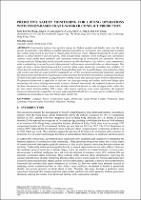Chapter Predictive Safety Monitoring for Lifting Operations with Vision-Based Crane-Worker Conflict Prediction
| dc.contributor.author | Lam, Chin Pok | |
| dc.contributor.author | Lee, Yin Ni | |
| dc.contributor.author | Ting, Chung Lam | |
| dc.contributor.author | Wong, Peter Kok-Yiu | |
| dc.contributor.author | Cheng, Jack C. P. | |
| dc.contributor.author | Leung, Pak Him | |
| dc.date.accessioned | 2024-04-02T15:45:31Z | |
| dc.date.available | 2024-04-02T15:45:31Z | |
| dc.date.issued | 2023 | |
| dc.identifier | ONIX_20240402_9791221502893_37 | |
| dc.identifier.issn | 2704-5846 | |
| dc.identifier.uri | https://library.oapen.org/handle/20.500.12657/89068 | |
| dc.description.abstract | Construction industry has reported among the highest accident and fatality rates over the past decade. In particular, crane lifting is a notably hazardous operation on construction sites, causing fatal accidents like workers being struck by the boom or objects fallen from tower cranes. Manual monitoring by on-site safety officers is labour-intensive and error-prone, while incorporating computer vision techniques into surveillance cameras would enable more automatic and continuous monitoring of construction site operations. However, existing studies for lifting safety mainly detect the presence of individual objects (e.g. workers, crane components), while a methodology is needed to predict their potential collision more proactively before accidents happen. This paper develops a vision-based framework for predictive lifting safety monitoring, including three modules: (1) object detection and classification: targeting at hook and lifting materials to enable danger zone estimation, along with workers and their personal protective equipment; (2) worker movement tracking and prediction: analyzing the historical moving trajectory of each unique worker to foresee his/her future movement in certain period ahead; (3) multi-level safety assessment: issuing predictive warning in real-time upon any crane-worker conflict foreseen. The proposed framework is applicable to real-time site video processing and enables end-to-end lifting safety monitoring with instant alerting upon unsafe scenarios observed. Importantly, the proposed framework predicts the future movement of workers to proactively identify potential site hazard, in order to trigger earlier safety alert for more timely decision-making. With a large video dataset capturing tower crane operations, the proposed framework demonstrates competitive accuracy and computational efficiency in crane-worker conflict prediction, validating its practicality for real-time lifting safety monitoring | |
| dc.language | English | |
| dc.relation.ispartofseries | Proceedings e report | |
| dc.subject.classification | thema EDItEUR::U Computing and Information Technology::UT Computer networking and communications::UTV Virtualization | |
| dc.subject.other | Computer Vision | |
| dc.subject.other | Construction Safety Monitoring | |
| dc.subject.other | Crane-Worker Conflict Prediction | |
| dc.subject.other | Deep Learning | |
| dc.subject.other | Predictive Safety Assessment | |
| dc.subject.other | Trajectory Tracking | |
| dc.title | Chapter Predictive Safety Monitoring for Lifting Operations with Vision-Based Crane-Worker Conflict Prediction | |
| dc.type | chapter | |
| oapen.identifier.doi | 10.36253/979-12-215-0289-3.64 | |
| oapen.relation.isPublishedBy | bf65d21a-78e5-4ba2-983a-dbfa90962870 | |
| oapen.relation.isbn | 9791221502893 | |
| oapen.series.number | 137 | |
| oapen.pages | 9 | |
| oapen.place.publication | Florence |

